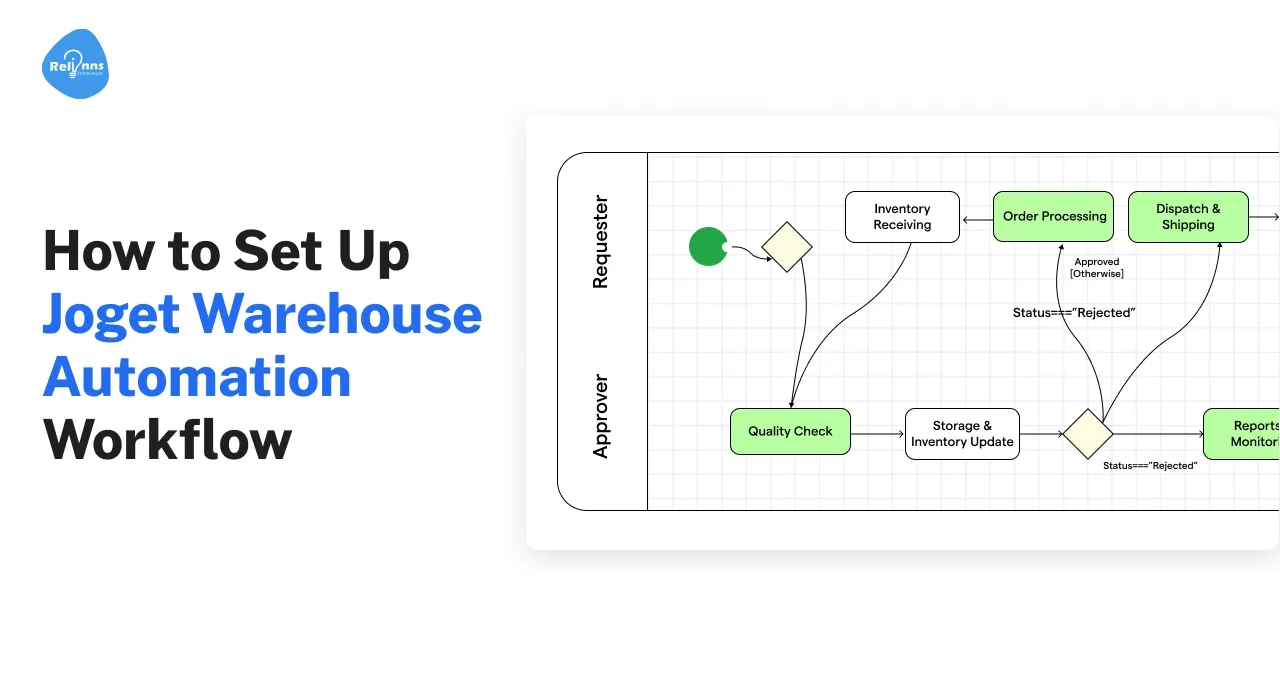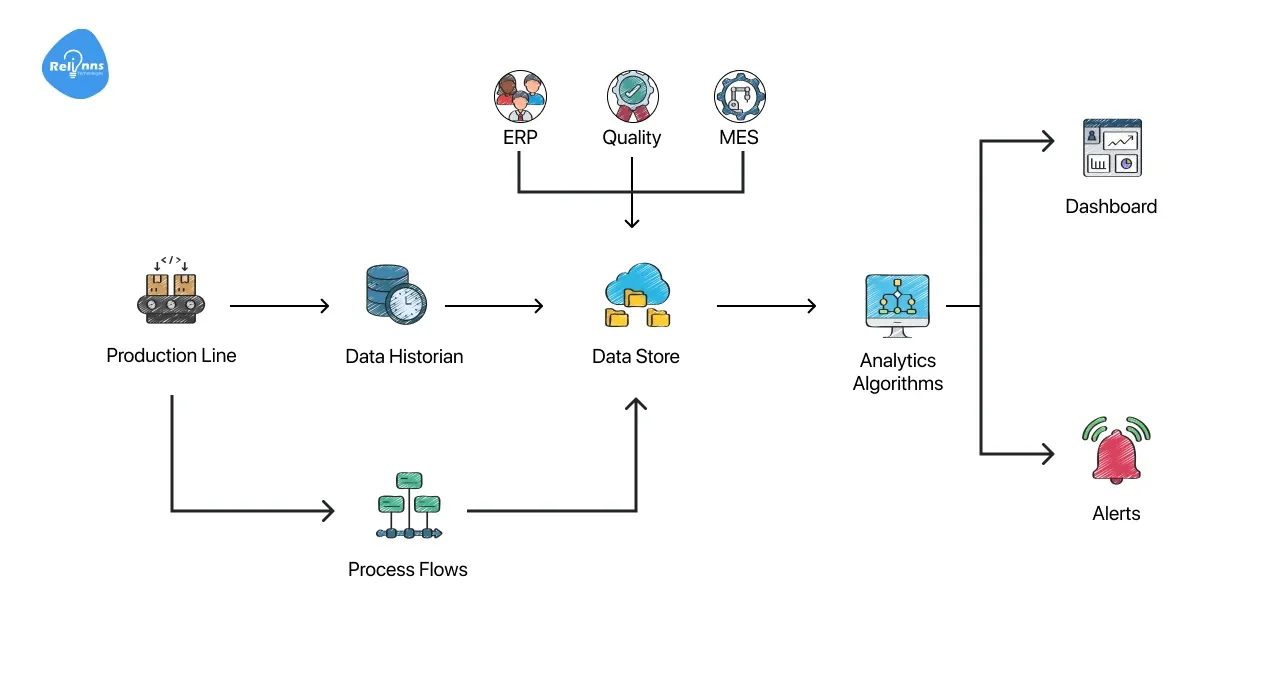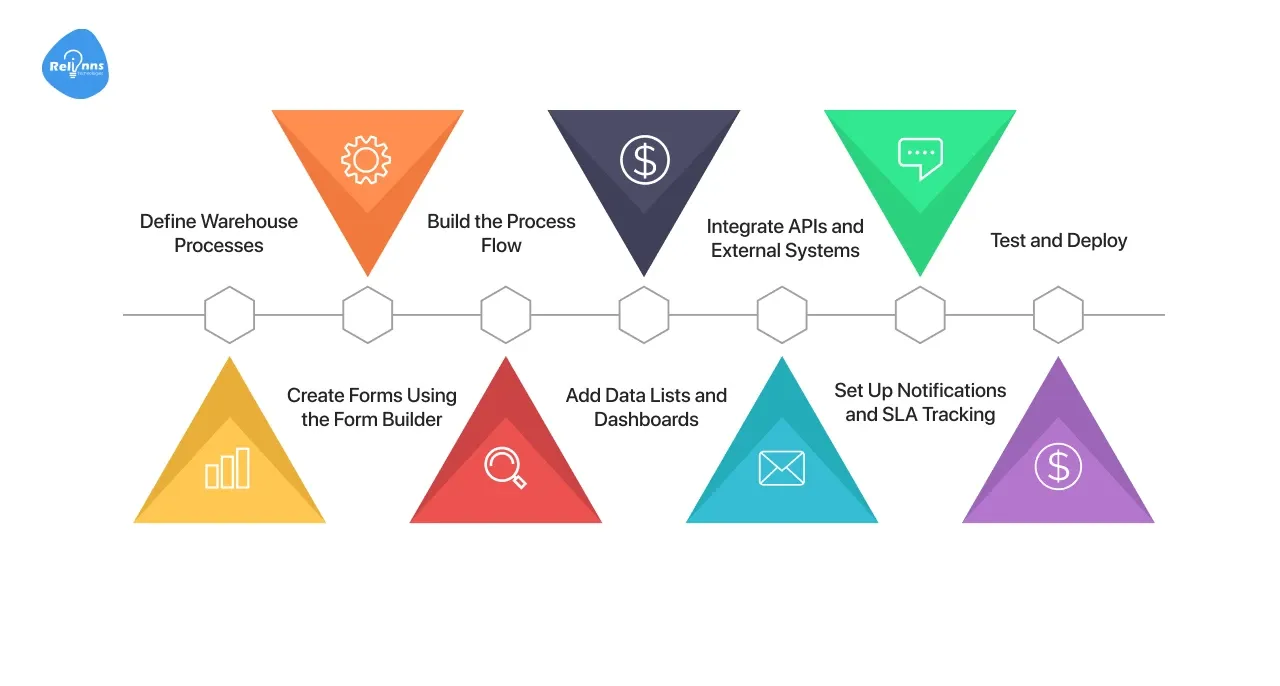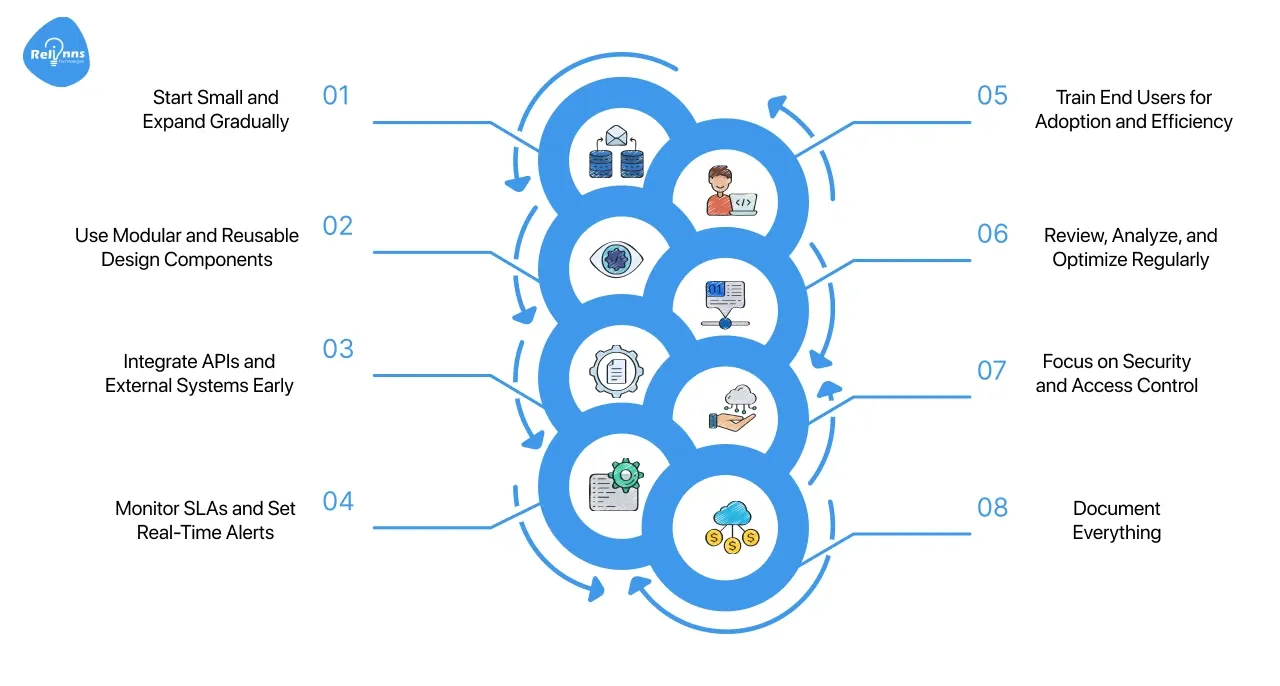How to Set Up Joget Warehouse Automation Workflow
Date
Nov 03, 25
Reading Time
8 Minutes
Category
Low-Code/No-Code Development

Warehouses are the heart of supply chains. But when inventory, shipments, and order processing rely on manual tracking, delays and errors become costly. Automation can solve this, but traditional systems require months of coding and heavy investments.
That’s where Joget, a leading low-code platform, steps in. It lets you create custom warehouse workflows without complex coding. Businesses can digitize processes such as inventory tracking, SLA monitoring, and shipment coordination in days rather than months.
In this guide, we’ll explore how to set up a warehouse automation workflow in Joget, step by step, and see how it transforms logistics operations for real results.
What Is a Warehouse Automation Workflow?

A warehouse automation workflow is a system that streamlines repetitive, manual operations into a single, connected digital process.
These workflows can automate:
- Stock updates when goods are received or shipped
- Purchase order approvals and vendor notifications
- SLA alerts for delayed shipments
- Invoice and delivery reconciliation
Without automation, data is fragmented across spreadsheets, emails, and manual logs. Warehouse teams spend more time on coordination than execution. A Joget-driven workflow unifies these activities, turning your warehouse into a real-time, intelligent operation.
Why Choose Joget for Warehouse Automation?
Joget simplifies workflow automation through its drag-and-drop, low-code interface. It empowers warehouse and logistics teams to digitize complex operations without needing software developers.
Here’s why Joget stands out for warehouse automation:
- Low-Code Flexibility: Design custom workflows, forms, and dashboards tailored to your warehouse operations.
- Fast Deployment: Build, test, and roll out workflows within days using visual builders.
- Seamless Integration: Connect with ERP, CRM, inventory systems, or third-party APIs for smooth data flow.
- Scalability: Handle thousands of SKUs, multiple locations, and dynamic order volumes with ease.
- SLA and Performance Tracking: Monitor delivery timelines, vendor SLAs, and performance metrics from one dashboard.
Joget also supports real-time analytics, helping warehouse managers make quick, data-backed decisions.
Step-by-Step Setup of Warehouse Automation Workflow in Joget

Setting up warehouse automation in Joget involves a series of structured steps. Each component of Joget’s platform, such as Process Builder, Form Builder, Data List Builder, and Userview Builder, plays a vital role in bringing the workflow to life.
Let’s go through the process.
Step 1: Define Warehouse Processes
Start by identifying what processes you want to automate. Examples include:
- Stock updates and inventory control
- Order fulfillment workflows
- Supplier approval and invoice processing
- Delivery tracking and SLA alerts
Create a process map outlining the data inputs (purchase orders, shipments) and the expected outcomes (approvals, alerts, reports). This ensures clarity before development begins.
Step 2: Create Forms Using the Form Builder
In Joget, forms are the foundation of your workflow.
Use the Form Builder to design:
- Inventory Form: Capture item details, SKUs, quantities, and storage zones.
- Supplier Form: Manage supplier data and compliance documentation.
- Order Form: Record customer orders, dispatch timelines, and delivery details.
These forms automatically integrate with the workflow once created, allowing real-time data capture and validation.
Step 3: Build the Process Flow
Now, switch to the Process Builder to define how these forms interact.
Use a drag-and-drop layout to connect tasks like:
- Inventory check → Approval → Dispatch → Notification
- PO creation → Manager approval → Vendor confirmation
Each stage can trigger automated actions, email notifications, API calls, or SLA timers. This process ensures warehouse activities move without manual bottlenecks.
Step 4: Add Data Lists and Dashboards
Warehouse operations need constant visibility. With Joget’s Data List Builder, you can display:
- Pending orders
- Low stock alerts
- SLA violations
- Shipment completion rates
Next, use Userview Builder to create dashboards that let warehouse managers view KPIs, approvals, and process metrics on a single screen.
Step 5: Integrate APIs and External Systems
Joget connects easily with:
- ERP systems (SAP, Oracle) for inventory sync
- CRM tools for order tracking
- IoT sensors or barcode scanners for live updates
Use the API Connector Plugin to integrate third-party systems. This ensures seamless information flow between departments, eliminating redundant data entry.
Step 6: Set Up Notifications and SLA Tracking
Joget allows you to define timers, SLAs, and auto-notifications.
For example:
- Send alerts when an order is delayed by more than 24 hours.
- Escalate to managers if inventory dips below the threshold.
- Trigger emails to vendors when invoices are due.
This level of automation reduces response times and ensures compliance with delivery timelines.
Step 7: Test and Deploy
Before going live:
- Test the entire workflow with dummy data.
- Verify API integrations and approval chains.
- Monitor system logs for potential errors.
Once verified, deploy the app from Joget’s App Center. Users can access it on desktop or mobile devices, ensuring operational continuity across teams.
Common Warehouse Processes You Can Automate with Joget

Joget is flexible enough to cover every primary function in warehouse management.
| Process | Description |
| Inventory Management | Auto-track stock movement, set reorder points, and sync with ERP systems. |
| Order Fulfillment | Automate picking, packing, and dispatch workflows. |
| Supplier Coordination | Digitize PO creation, approval, and invoice tracking. |
| SLA Compliance Monitoring | Monitor vendor performance and generate SLA reports. |
| Return and Refund Processing | Automate approvals, restocking, and refund notifications. |
By automating these areas, companies improve accuracy, reduce delays, and gain real-time control over logistics performance.
Challenges Solved by Joget Warehouse Workflows
Every warehouse operation faces a mix of recurring and unpredictable challenges, including managing fluctuating inventory, meeting delivery SLAs, and maintaining communication across multiple departments. These inefficiencies often slow down order fulfillment and affect customer satisfaction.
Joget workflows eliminate these friction points by digitizing and connecting every aspect of warehouse operations. Let’s look at how Joget addresses common problems faced by warehouse teams.
1. Manual Errors and Data Silos
Manual data entry remains one of the biggest causes of operational inefficiency. Traditional systems require employees to input data into multiple spreadsheets or software platforms, often leading to duplication and inconsistencies.
Joget centralizes all warehouse data in a unified, low-code platform. When an employee updates product quantities, initiates a delivery, or modifies a purchase order, the information automatically syncs across all related workflows. This real-time synchronization removes data silos between inventory, procurement, and logistics teams.
By minimizing manual input, warehouses experience fewer inventory mismatches, quicker processing, and complete visibility into every operation.
2. Lack of Real-Time Visibility
Without a unified system, warehouse managers struggle to monitor processes in real-time. Delays in approvals, missing shipment details, or outdated stock data often result in poor decision-making.
Joget addresses this through dynamic dashboards and datalists that give managers an instant overview of critical KPIs, order status, SLA breaches, inventory shortages, and warehouse utilization.
Custom dashboards can also be configured by department:
- The procurement team can view supplier performance metrics.
- The inventory team can monitor stock levels and reorder triggers.
- The dispatch team can track delivery SLAs and pending shipments.
This visibility allows teams to take proactive actions before issues escalate.
3. Slow Approvals and Process Bottlenecks
Traditional warehouses often depend on manual email chains for approvals. Whether it’s restocking requests or dispatch confirmations, delays are inevitable when multiple managers are involved.
Joget automates these workflows through its Process Builder, routing approvals to the appropriate person. For example:
- A purchase request is sent directly to a manager when inventory drops below a threshold.
- Delivery confirmation automatically triggers payment processing.
- Escalation rules ensure SLAs aren’t missed when someone’s out of the office.
With Joget, approvals are instant, transparent, and fully trackable, keeping warehouse operations running smoothly 24/7.
4. Compliance and Audit Challenges
Warehouses that manage multiple vendors or handle regulated goods often struggle with maintaining compliance. Tracking vendor documentation, safety records, or delivery SLAs manually leaves room for error.
Joget simplifies compliance through built-in audit trails and document management features. Every workflow activity, from a manager’s approval to a stock movement, is recorded and timestamped. This creates a tamper-proof audit record.
Additionally, Joget allows setting up automated notifications for policy renewals, vendor certifications, or contract expirations. This ensures your warehouse remains compliant at all times, without last-minute panic or paperwork overload.
5. Limited Integration Between Teams and Systems
A modern warehouse ecosystem involves multiple tools, ERP systems, barcode scanners, CRM software, and even IoT sensors. When these operate in silos, data synchronization becomes a major pain point.
Joget solves this using its API Connector and Integration Builder. You can connect Joget workflows directly with ERP systems like SAP, CRMs like HubSpot or Zoho, or even custom applications.
For instance, when a new shipment is logged via an IoT scanner, the Joget workflow can automatically update ERP inventory records and notify the logistics team in real time. This seamless integration removes data gaps, accelerates communication, and reduces human involvement in repetitive tasks.
6. Inefficient SLA and Performance Tracking
Meeting delivery timelines is essential in logistics, but tracking performance manually is unreliable. Joget allows you to configure SLA timers and escalation rules within workflows.
For example, if an order isn’t processed within a defined window, Joget automatically sends reminders or reassigns the task. Managers can also generate SLA compliance reports to identify recurring bottlenecks.
This feature ensures warehouses maintain high service reliability and transparency, which translates directly into customer trust and better retention.
7. High Operational Costs
Inefficient manual processes and disconnected systems directly contribute to rising operational costs. Joget’s automation drastically reduces the hours spent on repetitive activities, enabling teams to focus on value-driven tasks such as demand forecasting and vendor management.
With no-code scalability, Joget also removes the need for large IT teams to customize workflows. This results in faster ROI and lower total cost of ownership (TCO) than legacy warehouse management systems.
Best Practices for Setting Up Warehouse Automation in Joget

Designing a warehouse automation workflow in Joget is about more than digitizing processes. It’s about building a system that remains scalable, user-friendly, and integrated across multiple warehouse functions. The following best practices will help ensure your Joget warehouse application delivers consistent performance, visibility, and long-term efficiency.
1. Start Small and Expand Gradually
One of the biggest mistakes companies make is trying to automate everything at once. Instead, start by focusing on a single workflow, such as stock intake or dispatch management, and perfect that process before moving to others.
This approach allows teams to:
- Identify potential process gaps early.
- Gather feedback from end users.
- Measure ROI before scaling further.
Joget’s modular architecture supports incremental expansion, allowing you to add new workflows, dashboards, or reports without disrupting existing operations.
2. Use Modular and Reusable Design Components
Joget’s Form Builder, Process Builder, and Data List Builder allow you to create reusable components. For example, a “Supplier Information Form” or “Stock Approval Workflow” can be reused in multiple apps, saving time and maintaining consistency across the platform.
Here’s how modular design helps:
- Reduces development time for future workflows.
- Keeps user experience consistent.
- Simplifies updates, since changes to one component reflect everywhere it’s used.
Relinns’ Joget developers often design workflows as modules, ensuring faster customization for future upgrades or process expansions.
3. Integrate APIs and External Systems Early
Warehouse operations are rarely standalone. They rely on data from ERP, CRM, procurement, and shipping systems. Integrating these tools during the design phase ensures smooth communication between departments and eliminates rework later.
Joget’s API Connector Plugin allows integration with:
- ERP tools like SAP, Oracle, or Odoo
- CRM systems like Zoho or HubSpot
- IoT sensors or barcode scanners for real-time stock data
Early API planning ensures the workflow captures all critical data and delivers a unified view of operations.
4. Monitor SLAs and Set Real-Time Alerts
SLAs are the backbone of warehouse operations. Missing a delivery deadline or failing to restock on time can impact customer satisfaction and financial performance.
Joget enables SLA timers, auto-notifications, and escalation workflows that proactively alert managers before service levels are breached. Combine this with KPI dashboards to track performance metrics like:
- Order processing time
- Dispatch accuracy
- Supplier turnaround rates
Proactive monitoring ensures continuous improvement and accountability across the warehouse ecosystem.
5. Train End Users for Adoption and Efficiency
Even the most advanced workflow fails without user adoption. While Joget is designed for simplicity, structured onboarding helps employees adapt faster.
Recommended practices include:
- Conducting short internal training sessions for warehouse staff.
- Creating a user guide or walkthrough video for reference.
- Assigning workflow champions who can support peers during rollout.
The more confident your users are, the more efficiently your warehouse operates.
6. Review, Analyze, and Optimize Regularly
Warehouse automation isn’t a one-time setup; it’s an ongoing cycle of optimization. Once the system goes live, use Joget’s built-in analytics to monitor task completion times, bottlenecks, and error logs.
Relinns recommends conducting monthly reviews to evaluate:
- SLA performance
- User feedback
- Workflow efficiency metrics
This approach helps identify inefficiencies early and implement updates without downtime. With each iteration, the workflow becomes more streamlined and adaptive to business growth.
7. Focus on Security and Access Control
Warehouses handle sensitive information, vendor contracts, pricing details, and customer data. Joget’s role-based access control (RBAC) ensures that only authorized users can view or modify specific data.
Set up roles such as:
- Warehouse Admins (full access)
- Inventory Managers (limited form access)
- Finance Teams (approval-only access)
This maintains accountability, data integrity, and compliance with internal and external policies.
8. Document Everything
Finally, always document workflow logic, form designs, integration details, and escalation paths. This not only helps in audits but also simplifies future upgrades and maintenance.
Good documentation ensures business continuity if a key employee leaves; others can easily take over without process disruption.
Suggested Reading: Optimize E-commerce Fulfillment Using Custom Warehouse Apps
How Relinns Helps Build Custom Joget Warehouse Solutions
At Relinns Technologies, we specialize in Joget development and integration services. Our experts have designed workflows for logistics, eCommerce, and warehousing operations, with a focus on automation, compliance, and scalability.
Here’s how Relinns helps:
- Custom workflow design: Tailored warehouse automation built for your operations.
- Seamless integration: Connect Joget with ERP, CRM, and IoT systems.
- Scalable deployment: Handle multi-location warehouses and global teams.
- Analytics setup: Real-time dashboards for data-driven decision-making.
Relinns ensures your warehouse runs like a connected, efficient ecosystem powered by Joget.
Conclusion: The Future of Warehouse Efficiency with Joget
Warehouse management is evolving. Businesses no longer need months of coding or costly ERP customizations to achieve automation.
With Joget, workflows can be built, tested, and scaled visually without writing a single line of code.
When combined with expert implementation from Relinns, your warehouse becomes a seamless, intelligent system that boosts efficiency, compliance, and profitability.
The future of logistics automation is here, and it starts with Joget.
Frequently Asked Questions (FAQ's)
What is Joget warehouse automation?
Joget warehouse automation uses low-code workflows to digitize stock tracking, order processing, and delivery management.
Can Joget integrate with my existing ERP system?
Yes, Joget integrates with ERPs such as SAP, Oracle, and Odoo via API connectors to sync inventory and order data.
How long does it take to build a Joget warehouse workflow?
A basic workflow takes around 2–3 weeks to set up, depending on process complexity and integration requirements.
Is Joget suitable for multi-location warehouses?
Absolutely. Joget supports scalability across multiple warehouses with shared dashboards and centralized control.
Why choose Relinns for Joget workflow development?
Relinns provides end-to-end Joget expertise from workflow design to integration, ensuring your warehouse runs efficiently with measurable ROI.


